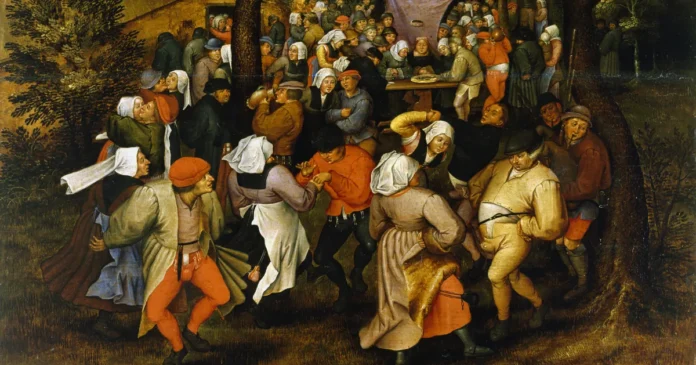Introduction: When Dancing Became Deadly
In the summer of 1518, the streets of Strasbourg (then part of the Holy Roman Empire, now modern-day France) witnessed a scene so strange, so disturbing, that it defies easy explanation. Dozens of people began to dance — not for joy, not for celebration — but uncontrollably. They danced for hours, then days, and eventually weeks. Some collapsed. Others died. What became known as the Dancing Plague of 1518 would go down in history as one of the most bizarre public health mysteries of all time.
The Strange Outbreak Begins

It all started in July 1518, when a woman known only as Frau Troffea stepped into the street and began to dance. She didn’t stop. For six straight days, she moved without rest. Within a week, more than 30 others had joined her. By the end of the month, the number grew to over 400.
These weren’t joyful, rhythmic dances. Eyewitnesses described jerking movements, trembling, and blank stares. Some dancers screamed in pain. Others seemed trapped in their own bodies.
What Happened in Strasbourg?
Strasbourg at the time was a bustling medieval city dealing with famine, disease, and political unrest. The streets were packed, resources were stretched, and tensions ran high.
City leaders were baffled. They first turned to physicians, who blamed the dancing on “hot blood.” Rather than stop the dancers, they encouraged more movement. A stage was built. Musicians were hired. The theory was: let them dance it out.
The result? Chaos. People collapsed from exhaustion, strokes, and even heart attacks. Contemporary records suggest that between 15 to 100 people may have died as a result.
Theories Behind the Dancing Plague
Even centuries later, historians and scientists are still puzzled by the Dancing Plague of 1518. Several theories have been proposed:
Mass Hysteria (Psychogenic Illness)
One of the most accepted theories is mass psychogenic illness. Under extreme stress, people may begin to experience physical symptoms collectively. With Strasbourg’s mix of poverty, disease, and superstition, the psychological toll may have triggered the outbreak.
Ergot Poisoning
Another theory suggests that bread contaminated with ergot fungus — the same mold that causes hallucinations (similar to LSD) — may have been the culprit. Ergot thrives on damp rye and can cause convulsions, delusions, and muscle spasms.
However, this doesn’t fully explain why only dancing was affected or why the behavior lasted so long.
Religious Fervor or Ritual
In a deeply religious society, some historians speculate the dancing may have been part of a trance-like devotional experience. St. Vitus, a Christian martyr, was often invoked against diseases involving convulsions. Some believe the dancers were caught in a spiritual panic.
Eyewitness Accounts and Historical Records
Chroniclers from the 16th century left behind detailed, if sometimes conflicting, accounts. One Strasbourg physician wrote: “Many danced until they broke their ribs. Some expired on the streets, foaming at the mouth.”
City council records confirm that the authorities saw the event as a public crisis. One letter from a local leader described it as a “plague sent from above or below, we know not which.”
These records give historians rare insight into how people of the time interpreted such a strange event.
Social and Political Context
To truly understand the Dancing Plague of 1518, you have to look at the backdrop. Strasbourg had just suffered a series of plagues and failed harvests. People were hungry, afraid, and deeply religious. The stress of daily survival may have created the perfect storm.
In the absence of scientific knowledge, fear and superstition often shaped responses to crises. The idea that spirits, saints, or demons could influence the body was widely accepted.
Could It Happen Again?
While it’s hard to imagine hundreds of people dancing themselves to death in modern times, mass hysteria hasn’t gone away. From mysterious illnesses in schools to viral social media panic, the human brain remains vulnerable to suggestion and stress.
Some researchers argue that under the right mix of pressure, fear, and group psychology, something similar — though likely less dramatic — could re-emerge.
Conclusion
The Dancing Plague of 1518 remains one of the most fascinating unsolved cases in medical and social history. Was it mass hysteria, poisoned bread, or a communal spiritual breakdown? We may never know for sure.
But one thing is certain: it reminds us that the human mind and body are more deeply connected — and more mysterious — than we often believe.
For further reading, you can explore the Public Domain Review article on the Dancing Plague and Smithsonian Magazine’s coverage of the event.





